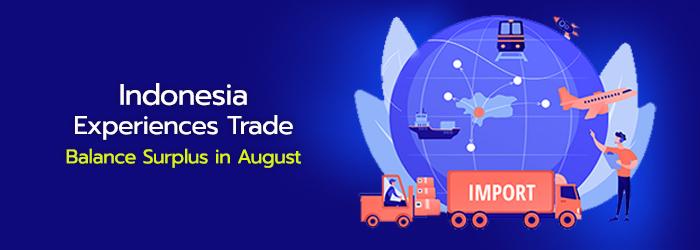Indonesia Experiences Trade Balance Surplus in August

Chairperson of the Fiscal Policy Agency of the Ministry of Finance, Febrio Kacaribu, stated that Indonesia’s trade balance recorded its highest surplus since 2006 in August 2021 at 4.74 billion USD. The latter is contributed by the surplus of non-oil and gas trade at 5.43 billion USD while the oil and gas trade experienced a deficit of 1.23 billion USD. Consequently, Indonesia has kept a trade balance surplus for the past 16 months consecutively. In January-August 2021, the total trade balance surplus had reached 19.17 billion USD.
Total exports in August 2021 were recorded at 21.42 billion USD, increasing by 20.95 percent (M-to-M) and 64.1 percent (YoY). The increase was supported by non-oil and gas exports which grew by 63.4 percent (YoY), and the oil and gas sector, which grew by 77.9 percent (YoY). Cumulatively, total exports during the year reached142.01 billion USD, or an increase of 37.77 percent year-to-date, dominated by CPO and mineral fuels.
According to Mr. Febrio, the increase in exports shows a signal of recovery in world demand. Therefore, businesses are expected to optimize the advantage of PEN programs and policies supporting export performance. Most sectors generally showed good performance, such as agriculture (coffee, fruit, and other non-timber forest products) which grew by 17.89 percent M-to-M despite its slight fall by 0.42 percent YoY. Furthermore, exports related to the processing industry also rose by 20.67 percent (M-to-M) and 52.62 percent (YoY), especially CPO, steel, and tin. Meanwhile, the mining industry, particularly coal, copper ore, and lignite, rose 27.23 percent (M-to-M) and 162.89 percent (YoY).
On the other side, the import value in August 2021 reached 16.86 billion USD, growing 10.35 percent M-to-M and 55.26 percent YoY. The increase is caused by the increasing oil and gas import to 115.75 percent YoY. Cumulatively, imports for the year reached 122.83 billion US dollars or grew 33.36 percent year-to-date.
Import of raw materials contributed 75.61 percent or grew 8.39 percent (M-to-M) and 59.59 percent (YoY). Meanwhile, imports of capital goods, which contributed 14.37 percent, rose 16.44 percent (M-to-M)) and 34.56 percent (YoY). Import of consumer goods, which contributed 10.02 percent, grew by 16.34 percent (M-to-M) and 58.23 percent (YoY). Mr. Febrio concluded that the increasing import of raw materials shows the rebound of Indonesian economics following its better COVID-19 situation.






